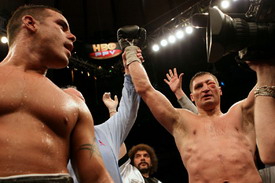 By Geoffrey Ciani, Photos by David Martin Warr – DKP: When Andrew Golota squared off against Mike Tyson back in October 2000, few fans will probably forget the disturbing image of Golota spitting out his mouth piece as he shoved trainer Al Certo out of his way in order to make an early exit from the ring. Fewer, still, are likely to forget the equally disturbing image of Golota being doused with debris from the angry crowd. Even his biggest detractors must have pitied the man as he made his disgraceful departure from the ring and the sport.
By Geoffrey Ciani, Photos by David Martin Warr – DKP: When Andrew Golota squared off against Mike Tyson back in October 2000, few fans will probably forget the disturbing image of Golota spitting out his mouth piece as he shoved trainer Al Certo out of his way in order to make an early exit from the ring. Fewer, still, are likely to forget the equally disturbing image of Golota being doused with debris from the angry crowd. Even his biggest detractors must have pitied the man as he made his disgraceful departure from the ring and the sport.
Quitting against Tyson was the final straw for the man who had already blown four previous opportunities on the big stage. When Golota twice battered former undisputed champion Riddick “Big Daddy” Bowe, he exhibited championship-caliber skills, but unfortunately, despite having the physical tools, he never possessed the mental make-up to compete at the top level. This was evidenced by his two disqualification losses against Bowe. He was clearly winning both fights, but his inability to resist hitting Bowe below the beltline cost him two guaranteed victories.
At the time, people wrote Golota off as some sort of nut job. In retrospect, many observers realize that this was a cry for help, and subsequent actions by Golota would confirm this, such as his abysmal performance against Lennox Lewis or the way he inexplicably quit against Michael Grant in a bout he was clearly winning. For whatever reason, Golota’s mental demons prevented him from succeeding at the elite level. It seemed no matter how well he performed, when the going got tough, Golota always managed to find new and innovative ways to blow it. Simply put, he could not handle adversity.
After the Tyson fiasco, it looked as if Golota was just another name in the long list of talented pugilists who had the all the physical skills required to be a champion, but lacked the mental stability necessary to do so. At the time, nobody would have suspected that Golota would mount a successful comeback in which he would receive three additional title shots. But after strong showings against both IBF champion Chris Byrd and WBA champion John Ruiz in 2004, Golota still did not manage to win a championship belt, even though many observers believe he won both contests.
The bouts against Byrd and Ruiz, in particular, the former, helped Golota redeem some of his past failures. He competed at a championship level without losing his cool, and made it to the final bell without seeking an early escape route. Many pundits anticipated a frustrated Golota who would be unable to cope with the peculiar style and tactics imposed by Byrd and Ruiz. However, Golota made a fair showing of himself in these fights and numerous spectators believed he got the shaft on the scorecards. Ergo, in the eyes of many, he had become an ‘unofficial’ unified champion.
This was pretty impressive for a man who was previously unable to cope with adversity. The list of examples where Golota had succumbed to pressure hitherto was rather lengthy, and they always left a lasting impression. Whether it was biting Sampson P’ohua on the neck like a vampire, using his head like a battering ram against Doc Nicholson, repeatedly hitting Riddick Bowe in the balls, the bizarre circumstances surrounding his bout with Lewis, or outright quitting against Grant and Tyson, Golota was a true connoisseur when it came to putting his mental shortcomings on full display.
After the Byrd and Ruiz bouts, it appeared Golota had gone full circle when he was destroyed in a mere 53 seconds against WBO champion Lamon Brewster. In the snap of a finger, any redemption founded in his efforts against Byrd and Ruiz had vanished into thin air. Although Golota did continue struggling to his feet after each of three knockdowns during the short duration of the contest, the fact that he did not quit was of little consolation. He had blown yet another opportunity on the big stage, and once again, it appeared as if Golota’s career was over.
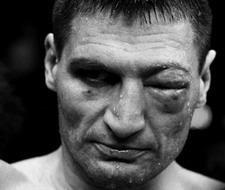 When it was announced that Golota would be fighting young fringe contender Mike Mollo as a part of last weekend’s Trinidad-Jones under card, it appeared Golota was once again setting himself up for disaster. After all, Mollo represented the type of fighter that always presented a stylistic nightmare for Golota—he was young, he was a fast-starter, and he could punch. The writing was on the wall for this one. How could a 40 year old Golota cope with a hungry young up-and-comer who was looking to make a big name for himself in his first opportunity under the big spotlight—the very same spotlight under which Golota had failed, time and time again.
When it was announced that Golota would be fighting young fringe contender Mike Mollo as a part of last weekend’s Trinidad-Jones under card, it appeared Golota was once again setting himself up for disaster. After all, Mollo represented the type of fighter that always presented a stylistic nightmare for Golota—he was young, he was a fast-starter, and he could punch. The writing was on the wall for this one. How could a 40 year old Golota cope with a hungry young up-and-comer who was looking to make a big name for himself in his first opportunity under the big spotlight—the very same spotlight under which Golota had failed, time and time again.
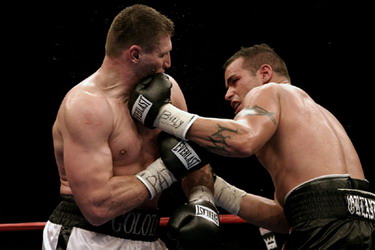
What transpired was most unexpected.
For the first time in his career, Golota actually overcame adversity. Not only was Mollo younger, faster, and stronger, but he also had more to fight for. Many observers believed that Golota was simply in this for a pay day, and that if the going got tough, Golota would find a way out, as he had done so often in the past. As expected, Mollo came out like a charging bull, unleashing furious punches intended to make quick work of Golota, much in the same way Brewster had done. After Golota survived the early storm, Mollo was forced to box, and despite his advanced age, Golota began getting the better of him.
Although he was painfully slow, especially compared to his younger years when he actually had deceptively quick hands, Golota’s right hand was finding its mark, and at first, Mollo had no answers. After a few rounds, Mollo began crowding Golota, which enabled him to escape the big Pole’s punching range. In the process, he managed to land some crippling blows—they were the type of punches which historically caused Golota to succumb to pressure, but in uncharacteristic style, Golota took the punches in stride without straying from his fight plan.
By the middle rounds, Andrew’s eye was badly swollen, and would eventually swell until it was completely shut with several rounds to go. Fighting with one eye, Golota kept his composure, and stuck to his game plan. Mollo was trying everything in his power to break Golota both physically and mentally, as evidenced by a few well-placed haymakers and some heated trash-talking, which actually amounted to outright taunting. Still, Golota did not fold and continued about his business, all the while fighting with just one functioning eye.
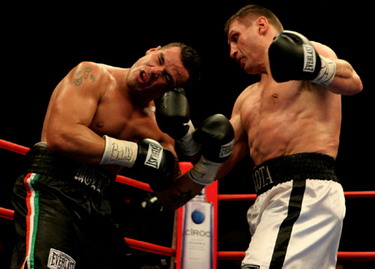
In the end, Golota emerged as the victor, having outworked and out-hustled his younger foe down the stretch. For the first time ever, he overcame adversity. When the going got tough, instead of searching for an easy exit, Golota hung in there and gave it his all. It was such a heroic performance that even HBO commentator Manny Steward noted that Golota had become his “personal hero” that evening. And lest we forget, this is the same Manny Steward who once despised Golota, dating back to when he head-butted Steward’s rising heavyweight prospect, Doc Nicholson. That Steward would commend Golota’s brave effort speaks volumes about his performance.
This was true redemption for Golota. Unlike his fights with Byrd and Ruiz, where he was never in any serious trouble, Mollo proved a determined foe, able to cause a multitude of problems for the aging fighter. Where Byrd and Ruiz failed, Mollo succeeded in hurting Golota each and every time he loaded up with a big punch.
The image of Golota’s hand being raised in victory, with one eye grotesquely swollen shut, was a fitting end to this enigmatic journey. Compared to the image of Golota being peppered with debris from an angry crowd when he quit against Mike Tyson, what better closure can Golota have hoped for? He defeated a younger opponent who was a local rival and did it on the big stage at Madison Square Garden—the very same venue which brought him notoriety some dozen years earlier. It was a brave performance that, in part, helped reverse some of his past failures. Golota was not in it for the money, he was in it for redemption.
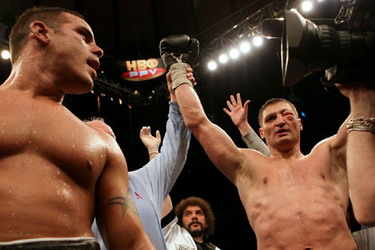
This would be the perfect way to end his career—a true storybook ending. Even though this victory may put him in line for yet another title shot down the road, I think Golota achieved something more important than winning an alphabet title—he overcame adversity. It is kind of ironic, actually. Golota once had all of the physical tools to compete at the top level but he lacked the mental fortitude. Now, at age 40, he no longer has the tools to compete amongst the division’s elite, but he has finally acquired the mental capacity needed to cope with that level. As they say, better late than never.
To contact Ciani:
geoff@eatthemushroom.com
To read more by Ciani please visit The Mushroom Mag:
http://www.eatthemushroom.com/mag